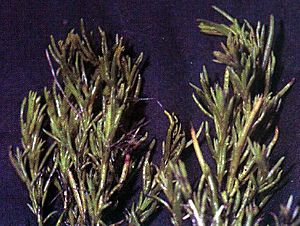Suaeda calceoliformis facts for kids
Quick facts for kids Suaeda calceoliformis |
|
|---|---|
 |
|
| Scientific classification | |
| Genus: |
Suaeda
|
| Species: |
calceoliformis
|
| Synonyms | |
|
|
Suaeda calceoliformis is a type of flowering plant. It belongs to the Amaranthaceae family. People often call it Pursh seepweed or horned seablite. This plant is special because it can live in very salty places.
Where It Lives: Salty Homes
This plant is originally from North America. You can find it in most parts of the continent. It grows almost everywhere except for some areas in the Southeastern U.S..
Suaeda calceoliformis loves salty places. It is known as a halophyte. This means it can grow well in soils with lots of salt or high alkalinity. You might spot it in places like:
- Dry lakebeds (called playas)
- Salt flats
- Beaches
- Marshes and other wet areas
- Along roadsides that get salted in winter
What It Looks Like: A Waxy Plant
Suaeda calceoliformis is an annual herb. This means it lives for only one growing season. Its stems can be green, red, or even striped with two colors. They can grow up to 80 centimeters (about 31 inches) long.
The plant can grow in different ways:
- Upright: Standing tall.
- Sprawling: Lying flat on the ground.
Plants that lie flat are more common in very salty soil. This shape helps them hold onto more water.
Leaves and Flowers
The leaves of Suaeda calceoliformis are thick and waxy. They can be up to 4 centimeters (about 1.5 inches) long. They are long and thin, and they grow close to the stem.
The flowers grow in a long, branching cluster called an inflorescence. This cluster looks like a spike. The flowers are packed tightly together. Small, leaf-like parts called bracts grow between the flower clusters.
Each cluster usually has three to five flowers. Each flower has a cup-like part called a calyx. This calyx has horn-shaped parts. These plants do not have petals.
Fruit
After the flowers, a small fruit grows. It is called an utricle. This fruit stays inside the calyx.

